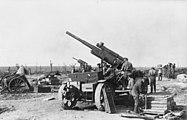Contents
The 8.8 cm Flak 16 was a German 8.8 cm anti-aircraft gun from World War I, forerunner of the 8,8 cm FlaK/PaK Flak 18/36/37 of World War II. Its contemporary name was the 8,8 cm K.Zugflak L/45.
Development
Designs for dedicated anti-aircraft guns existed before World War I, but few were in service by the outbreak of war. Early anti-aircraft artillery guns used in World War I were primarily adaptations of existing medium-caliber weapons, mounted to enable fire at higher angles. By 1915, the German military command realized that these were useless for anything beyond deterrence, even against vulnerable balloons and slow-moving aircraft.[2] With the increase of aircraft performance, many armies developed dedicated AA guns with a high muzzle velocity – allowing the projectiles to reach greater altitudes. The first such German gun, the Flak 16, was introduced in 1917, using the 88 mm caliber, common in the Kaiserliche Marine.[2]
Design
The barrel for the 8.8 cm K.Zugflak L/45 was built from steel and was 45 calibers in length. The gun had a semi-automatic Krupp horizontal sliding-wedge breech to boost its rate of fire. There was a hydro-pneumatic recoil system located above and below the barrel, along with an equilibriator to balance the gun. The gun was capable of 360° of traverse and -4° to +70° of elevation.
See also
Photo Gallery
References
- ^ a b c Fleischer, Wolfgang (February 2015). German Artillery:1914-1918. Barnsley. p. 94. ISBN 9781473823983. OCLC 893163385.
{{cite book}}: CS1 maint: location missing publisher (link) - ^ a b Westermann, Edward B. (2005–2009) [2001]. Flak: German Anti-aircraft Defenses 1914-1945. Modern War Studies. University Press of Kansas. pp. 19, 36–38, 44, 53, 58, 83, 90, 108, 128–129. ISBN 9780700614202.




